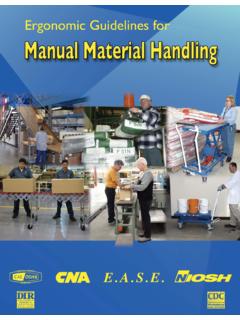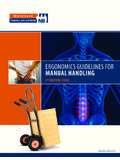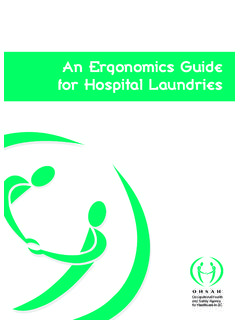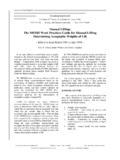Transcription of Principles of Hand Tool Selection - …
1 Repetitive use of manualor powered hand tools is oftena factor in carpal tunnel syn-drome and other hand and wristdisorders. While most tools aresatisfactory for general purposeuse, they may be entirely inappropriate for con-tinual or repetitive use in a production instance, a 15-pound hand tool may be per-fectly acceptable for occasional use,1 but tools thatare used frequently or repetitively should weigh nomore than 4 pounds ( kg).2 In addition, theworking environment as a whole may also haveto be evaluated and corrected. A properly designedhand tool used in an awkward posture will notsolve the tools vary con-siderably in shape, size,and weight. The way atool is designed influ-ences the hand positionsand motions that are re-quired to use it. Fortu-nately, there are typicallyseveral designs to choosefrom in each tool cat-egory.
2 Ask workers fortheir opinion about thetools you of maintenanceand repair should also bea consideration in tool se-lection. Proper mainte-nance, such as keepingbits sharp, will help mini-mize of Hand tool SelectionThis reference note gives some of the ergo-nomic Principles that can help guide you inselecting the proper manual or powered handtools for repetitive PrinciplesBefore selecting any tool , you should firstensure that the work area is ergonomically sound interms of work surface height, adjustable seating,acceptable manual handling requirements, etc. (SeeLP 185, Ergonomic Recommendations for Work-place Design. ) Tilting the work surface or usingfixtures to hold, tilt, or rotate the work can helpminimize awkward wrist motions and simplifytool hand tools,rather than manual ,should be used wheneverpossible, because re-peated manual exertionis more likely to causediscomfort and for tool designsthat allow the user to keepthe elbows in close to thebody.
3 While using a handtool, the worker should nothave to reach more than15 inches (38 cm). Thetool design should also al-low users to keep theirforearms at right angles tothe upper arms, and thewrists straight or in a natu-ral position. It is much bet-ter to bend the tool than tobend the to AvoidWhen Selecting Hand ToolsnSharp edges and corners on tool handles, which concentrate largeforces into small areas of the or highly polished handles or handles withrecesses that fit only one size of curved handles the curvatureshould be less than inches ( cm)over the and shears with finger loops thatcause excessive pressure on the thumband fingers (if possible, use power cuttersinstead).nTools that require workers to use a pinchor precision tool handles that press into the palmof the Prevention Reference NoteLP 190 R4 2004 Liberty Mutual Group - All Rights ReservedJanuary 20012 Power tool models may have pistol-grip,right-angle grip, or in-line handles.
4 Pistol-griptool handles should be at an angle of approxi-mately 80 11 from the long axis of the tool . In-line tool handles may have straight, offset, orright-angled heads. Hand tools such as pliers canbe obtained with bent handles (so-called ergo-nomic pliers) or in curved-nose is advised when using bent-handledtools in the workplace. The optimum angle withrespect to wrist deviation depends on the heightof work. Research has shown bent-handled toolsare best used when work heights are located atelbow height. Workspaces at elbow height opti-mize straight wrist operations and , workspaces with work heights aboveor below elbow height increase wrist deviationand decrease appropriate diameter of the handle (orthe part of the tool that the user holds) depends onthe way it is gripped and the size of the worker shand.
5 As Figure 1 shows, the recommendeddiameter for tools that require a power grip is inthe range of 1 to inches ( to 4 cm); for ahook grip inches (2 cm); and for a precisionor pinch grip at least inches ( cm). manual Hand ToolsWhen selecting manual hand tools, look fortool designs that have the following features:nHandles that use a power grip and that arelonger than hand breadth that is, at least 4inches ( cm), but preferably more than 5inches (13 cm) sizes for workers with differentsized hands . The handle diameter should inches (1 cm) smaller than the user s gripdiameter measured with the thumb meetingthe middle handle which, when gripped, distributesforces over all fingers and the entire surfaceof the following guidelines apply to pliers-type manual hand tools, including wire cutters,scissors, and pop riveters:Figure 1.
6 Recommended tool handlediameters for various possible, select tools that can be used witheither hand. This not only helps accommodateleft-handed workers, but for some tasks, it letsworkers switch hands to reduce the repetitivestress on either hand. Many hand tools normallydesigned for right-handed use are also availablein left-handed HandlesHandles should be slip-resistant, either bymaterial or by design. If available, select toolswith rubber or plastic foam-covered handles orgrips. This cushioning helps to cover sharp edges,increases the diameter of narrow handles, andprovides a more slip-resistant and comfortablegrip. On some power tools, it may also help todampen the effects of tool the pliers are fully closed, the spacebetween the pliers handles should be at least1 inch ( cm).
7 For tools that are squeezedwith two hands , the space should be at least2 inches ( cm).nIf the pliers-type handlesmust beopened andclosed duringtool opera-tion, theyshould be nomore than apart( cm) when fully opened (this is the opengrip span).nIf high squeeze forces are required, the gripspan should be in the range of 2 to inches(5 to 6 cm).4 The smaller size is better forusers with small tasks requiring sustained effort ( 1 min.),grip forces should not exceed 25 pounds( kg) for ungloved hands , and 22 pounds( kg) for gloved action should return the handles tothe open the handle has an opening for fingers ( ,conventional snips or scissors), the handleshould allow at least 5 inches (12 cm) spreadfor the fingers and an additional 1 inch ( ) if gloves are Hand ToolsWhen selecting power tools, keep these con-siderations in mind:nFor power tool use on a horizontal surface,adjust the surface height so that the work is keptat or below elbow height.
8 If the work cannot bekept at this level, use tools with in-line the tool is operated by means of a trigger,consider tools with an extended trigger thatcan be operated by two or more fingerstogether, or tools with a thumb trigger (thethumb is much stronger than the other fin-gers). Avoid designs where the index fingerwill be overused for tool scenter of grav-ity shouldalign with thecenter of thegraspinghand, so thatthe hand willnot have tocompensatefor rotational moments or torque of the tools should be designed to minimizevibration, rotational torque, or impact forceson the hand and GuidelinesMuch of the research data on hand toolscomes from studies of grip strength at a varietyof postures and psychophysical methodology is what peoplefeel to be the right weight, maximum force, orsize in some data in Table 1 (next page) come prima-rily from psychophysics and can be used toidentify what a large percentage of the popula-tion can do without overexertion.
9 In general, themaximum acceptable force for repetitive exer-tion is 30% of a maximum voluntary contraction(MVC).6 For example, a worker who can grip a toolwith 15 pounds of force at his or her MVC shouldonly use a grip (30% of 15 pounds) toavoid overexertion during repetitive of the force and torque requirementsof a task are difficult to measure. Consult yourLoss Prevention consultant for inches4 Printed in D., Localized muscle fatigue, defi-nition and measurement, Journal of Occu-pational Medicine, 15:346, , T., Punnett, L., and Ketner, P., Subjective worker assessments of hand toolsused in automobile assembly, AmericanIndustrial Hygiene Association Journal,50(12):639-645, , D., and Andersson, G., In Occupa-tional Biomechanics, John Wiley & Sons,New York, , S., and Radwin, R.
10 , Pistol grip powertool handle and trigger size effects on gripexertions and operator performance, Hu-man Factors, 35(3), 551-569, 1. Force Guidelines For tool SelectionPower pounds for to ; 10 pounds for < pounds for <2-inch grip7 Pinch pounds7 Wrench (8-inch)User inch-pounds8,1 User inch-pounds8,1 Socket Wrench (10-inch)User inch-pounds8,1 User inch-pounds8,1 Screwdriver (10-inch)User inch-pounds8,1 User inch-pounds8,1 Rotating ToolsIn-Line inch-pounds9 Trigger ForcesSingle-Finger pounds7 Note: These grip forces should be reduced by atleast 25% if the tool user wears illustrations, instructions and Principles contained in the material are general in scope and, to the best of our knowledge,current at the time of publication. No attempt has been made to interpret any referenced codes, standards or refer to the appropriate code-, standard-, or regulation-making authority for interpretation or clarification.







